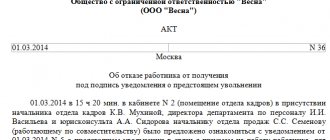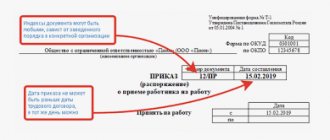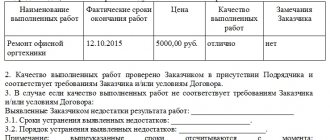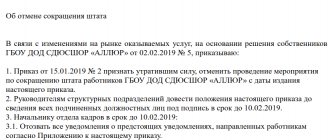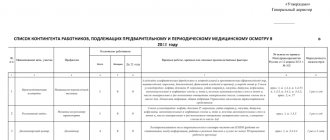Options for combining jobs and positions in an organization
Under the concept of “combination”, disclosed in Art. 60.2 of the Labor Code of the Russian Federation, a fairly large number of additional work functions performed during official time are covered:
- increasing the volume of work for the same position and specialization (for example, performing work for two similar positions in one department in the absence of a second employee);
- performing work for a temporarily absent colleague (for example, for an employee on maternity leave);
- combination of positions or professions (in essence, these are the same thing, but the term “profession” is more often used for working or technical areas, and “position” for management and specialists).
about the essence of the difference between internal part-time and internal combination in the material “Registration of combining positions in one organization.”
On our forum you can ask any question you have while working with personnel documents. For example, here we discuss how to formalize the combination of positions in the 1C program.
The difference between part-time and combination
In legislation, these concepts are distinguished according to the following criteria.
| Part-time job | Combination |
| Work period | |
| In free time from main responsibilities | During the main working hours at the enterprise where the employee performs his main duties |
| Decor | |
| A separate employment contract is required (Article 282 of the Labor Code of the Russian Federation) | No need for a separate employment contract |
| Working hours | |
| Has restrictions and cannot exceed 4 hours a day (Article 284 of the Labor Code of the Russian Federation) | Equal to the duration of the employee’s main working time (Part 1 of Article 60.2 of the Labor Code of the Russian Federation) |
| Rules for calculating surcharges | |
| Payments are made in proportion to the hours worked, depending on output or on other conditions that are stipulated in the employment contract (Article 285 of the Labor Code of the Russian Federation) | The employee is paid extra (Article 151 of the Labor Code of the Russian Federation) |
Features of registration of combining positions (professions)
1. The possibility of combination must be documented.
To do this, several conditions must be met:
- a position with multiple functions must be included in the staffing table;
- this position should not be occupied by a full-time employee for whom it is the main one.
2. Written confirmation from the employee of consent to the additional workload is required.
There are two possible scenarios:
- the employee himself writes an application with a request to assign him additional functionality, and the manager endorses him, expressing his consent;
- the head of the department draws up a document imposing additional duties on the employee, the employee signs that he agrees.
3. An additional agreement to the employment contract with the employee must be drawn up, which will become an integral part of this contract. It must include the following items:
- about the type of additional workload (combining positions, increasing regular responsibilities, etc.);
- the terms for which the combination is established;
- a list of additional functions (or a link to the corresponding job description);
- if the employee wrote the application himself (according to the first scenario), information that the combination was assigned at the request of the employee;
- on the amount of compensation for additional workload.
4. Special conditions are drawn up in cases where additional functionality requires professional qualifications, permits and certifications. In this case you should:
- request from the employee additional documents confirming his right and ability to perform these types of work;
- include special requirements and information about their compliance in personnel documents.
ConsultantPlus experts explained how to make significant changes to the terms of the contract. Study the material by getting free trial access to the system. If certain provisions of the employment contract are changed, the employer is required to report in the SZV-TD form. Whether an employer must submit information in the SZV-TD form about an employee who has registered a combination of positions can be found out in this material from ConsultantPlus.
Read more about personnel documents in the article “Personnel documents that should be in the organization .
Definition of multiple positions
Of course, such a term does not imply simultaneous work in the literal sense. The employee enters into a separate employment contract with the employer and performs additional duties in his free time from his main job.
There are two types of part-time work:
- Internal – the employee works within the same company.
- External – in this case we are talking about working in another company.
You cannot assign part-time work to persons under 18 years of age. If the main position is associated with hazardous working conditions, then combining activities under the same conditions is also prohibited. Also, the legislator does not allow a number of civil servants to work simultaneously in two jobs. A complete list of professions is contained in the text of the Labor Code of the Russian Federation.
For internal combination of professions, the following conditions must be met:
- Vacant position at the enterprise;
- Availability of an additional labor agreement>;
- Separate recording of working hours>;
- An administrative document has been issued;
A manager may wonder about the differences between the concepts of internal part-time work and combination of professions.
The terms differ in their essence:
- Internal part-time work – performing the duties of an employee simultaneously in two positions within the enterprise under Art. 60.1 Labor Code of the Russian Federation.
- Combination of professions - fulfillment of additional obligations in another profession for additional remuneration under Art. 60.2 Labor Code of the Russian Federation
The first option involves drawing up a special agreement between the employee and the company. At the same time, a part-time worker cannot work more than 4 hours in a second position.
The second option is possible based on the additional conclusion. agreements. At the same time, the deadlines for performing duties and the amount of work are established by the administration. The work is performed with the consent of the employee, and the basic salary is increased proportionately.
Order on combining positions
The order for combination is the basis for the employee to begin working in additional functionality.
It is published subject to availability:
- A document with the employee’s written consent.
- Agreements to the employment contract.
The order must necessarily contain the following information:
- Characteristics of the type of additional work.
- Specification of the position for which the combination is assigned (according to the staffing table).
- Start and end dates (if the contract is fixed-term) of the combined work.
- Description (list) of additional functionality (or reference to the regulatory document).
- Agreed amount of compensation (can be set either as a fixed amount for the period or as a percentage of the salary for the combined position).
To find out what place this compensation occupies in the salary structure, read the material “What does a salary consist of?”.
Combination term
The deadline is indicated in each document accompanying the registration procedure of the combination. A prerequisite is the start date of additional work. If the combination is established for a certain period, then the end date is also indicated.
When the alignment stops
If an employee wants to stop working additionally, he must notify the organization no later than 3 working days in advance (Article 60.2 of the Labor Code of the Russian Federation). A similar rule applies to the employer.
If the employee himself refuses the additional position, he needs to fill out an application that contains a request to cancel the corresponding additional agreement. It is drawn up in any form, the reasons do not play a role. The statement states:
- the date of its preparation;
- Full name to whom the document is addressed (director, direct superior, etc.);
- the request to cancel the agreement itself (as concisely and concisely as possible);
- applicant's signature.
If the head of the enterprise decides to terminate the procedure, he must notify the employee about this. It is also necessary to fill out a sample order for the removal of combined positions.
Sample order on combining positions (according to the unified form KP-152)
The current regulations do not establish a unified form of order for combining positions.
The HR manager has several options:
- Draw up an order in free form, taking into account all requirements and circumstances.
- Finalize the form approved by Goskomstat (usually they take the T-1 form and include additional parameters in it).
- Take advantage of the legacy of the USSR (in those parts that do not contradict current laws). In addition to detailed instructions for registering combinations (which are mostly used now), in the USSR there was a form of order for personnel KP-152 for combining positions (professions). If such a form is used, it must be approved for use within the organization. To do this, the head of the organization places an approval stamp in the upper right corner of the document.
The proposed sample order for combination is drawn up according to the KP-152 form.
Order to transfer an employee to another job
The procedure for forming an order for transfer to another job is similar to the procedure used when registering a combination. The difference is that upon transfer, the employee’s previous responsibilities are removed. Accordingly, payment for new duties is assigned to the new position. Since there is no combination of functions for two jobs, there is no additional compensation.
In contrast to the combination order, for the transfer order there is a separate form T-5 “Order on the transfer of an employee to another job,” approved by Resolution of the State Statistics Committee of the Russian Federation dated January 5, 2004 No. 1.
You will find the T-5 form in the article .
Find out in ConsultantPlus how much additional payment is made for combining a vacant position. If you don't already have access to the system, get a free trial online.
Who might be suitable for combination?
An ordinary case is the combination of positions within the same category. But it happens that an employee with the same job descriptions and tasks wants to perform diametrically opposed ones. The law does not prohibit such a combination. The main thing is that the candidate meets the necessary requirements, including qualifications, medical ones, and has the necessary knowledge and skills or shows potential for their development. Only extremely short-sighted managers agree to issue an order to combine positions for an unprepared employee.
What positions can be combined?
As a rule, combining positions is possible within the same category of workers: blue-collar workers, office workers, specialists, etc. But this is rather a tradition, since the current labor legislation does not contain such a rule.
Restrictions on the possibility of combining positions are imposed by other conditions. For example, the employee’s qualifications may not correspond to the new position, or work in the position requires additional documents (for example, medical clearance).
Results
The current Labor Code of the Russian Federation contains only general provisions regarding the registration of combining positions. To detail them, you can use the regulatory documents of the former USSR, which do not contradict the norms of the new laws:
- Resolution of the USSR Council of Ministers “On the procedure and conditions for combining professions (positions)” dated December 4, 1981 No. 1145;
- instructions of the All-Russian Central Council of Trade Unions, the Ministry of Finance of the USSR, the State Committee for Labor of the USSR “On the application of the resolution of December 4, 1981 No. 1145” dated May 14, 1982 No. 53-VL.
There is no unified form for issuing an order to combine positions.
You can find more complete information on the topic in ConsultantPlus. Free trial access to the system for 2 days.

